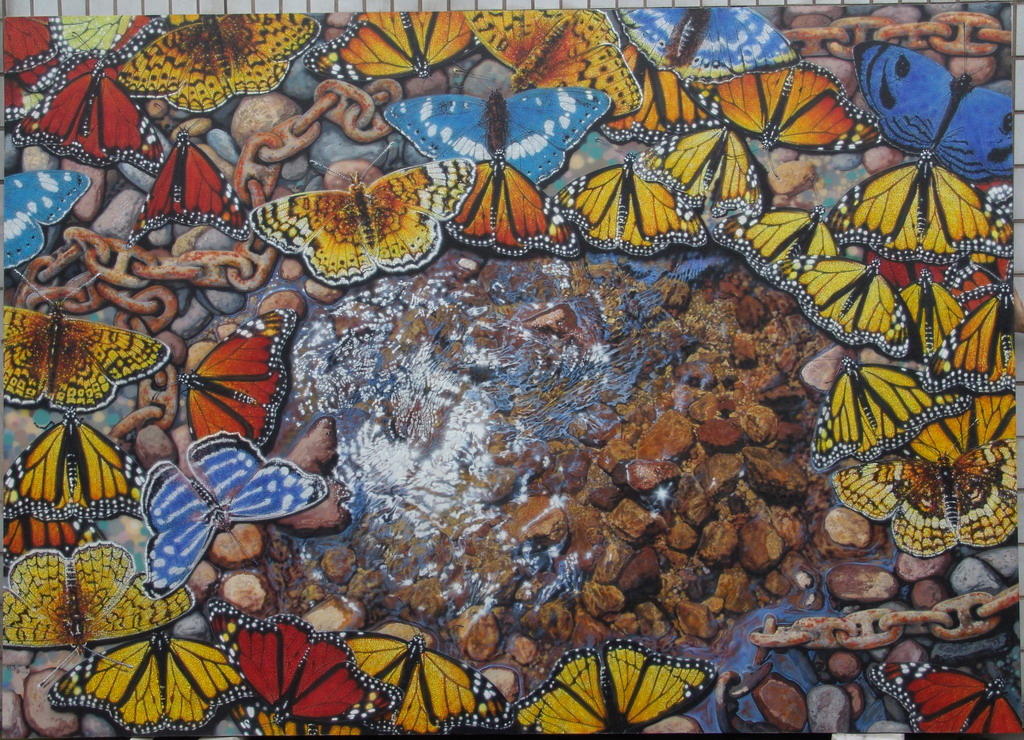曹靜萍:另類世界中的世界
范迪安
曹靜萍:另類世界中的世界
(Cao Jingping:Worlds within other worlds)
范迪安

在看到曹靜萍作品的第一眼時,我想人們都會爲他的作品展示了一個驚人的昆蟲世界而詫异,這種把人的第一眼視綫抓住的魅力,很顯然來自于他的作品把人帶進了一個迫近昆蟲世界的領地——它們就在這裏,就在眼前。對曹靜萍作品的這種最初感覺與我們在傳媒時代所形成的感性經驗是有關係的,實際上,我們已經從大量電影、電視和攝影上見過類似的畫面或場景。比如中央電視臺(CCTV)最受歡迎的節目《人與自然》、《動物世界》就經常播放近距離觀察和拍攝到的昆蟲世界,而這類節目往往是從外國的版本譯介過來的,這說明從外國到中國,對動物世界的關注已經成爲現代人精神生活的需要。動物世界,諸如走獸的世界、飛禽的世界、昆蟲的世界,讓人看到了自身類別的之外生命的存在和它們生活的方式,尤其喚起關愛整個生態世界的良知,也就是人性的體現。沒有動物世界,人性就缺少了參照,人性的泯滅就會在不知不覺中産生,所以電影、錄相和照片把動物世界呈現在人們面前,滿足了今日人們發自內心的自省性的需要。此外,也可以說與感性經驗直接關聯的,是許多關于動物世界的圖像,借助高科技手段,以微觀的方式將動物的存在推到了人們的眼簾面前,被高倍放大的一個小小昆蟲——它的動姿、色彩、肌理、質感,竟然是一個連想象也編織不出來的奇妙世界,是一個對應了現代生活空間的世界,于是人們對這個世界增加了興奮與興趣。由此來看曹靜萍的繪畫,他成了今日人們所需要傾訴、表現、投射的對動物的那份關懷的代言人:在他的筆下,昆蟲的小小生命——蝴蝶、蚱蜢、蜻蜓、甲蟲等等——以動感的姿態和奇异的色彩,顯示了它們的存在和活力,這是一種很直接也很坦率的對昆蟲的關注之心,所以他的作品在描繪物件上首先引起了人們的心理共鳴。他爲昆蟲們塑造形象時,受到了其他活動影像的啓發,或者說,他也在創造一種如同活動影像般近距離觀察昆蟲世界的視角,從而把一個微觀世界淋漓盡致的展現出來,這就讓人們的視覺獲得了驚喜的滿足和驚异的感覺。他極大的發揮了繪畫的主動性長處和丙烯材料的材質特點,將昆蟲儀態畫得生龍活現,尤其是在色彩上堪稱斑斕燦爛,驚艶奪人,閃耀著迷幻的光彩,抓住了用視覺方式打動人的當代繪畫所需要的特點。主題相關加上視覺通感,構成了曹靜萍的作品與觀衆的心理聯繫,也使曹靜萍的作品具有鮮明的當代繪畫屬性。
實際上,曹靜萍的作品要表達的東西比一般影視圖像所做的直接介紹要深刻和內在得多,他筆下的昆蟲不是生活在它們的原生環境裏,而是被置放在一個异化了的空間之中。在他的畫中,與昆蟲相連的是一段段銹蝕斑斑的工業廢料,很顯然,它們是人的世界的産物,是現代文明所導致的被污染的環境的組成部分,只是它們存在于被美麗的環境外表所掩飾的深處。生命的昆蟲處在這種异化的空間中,與人的惡性作爲的結果相伴,不能不顯示出一種生命的危險。由此可見,他的藝術又是一種理性思考和文化省視的結果。他用披著艶美光彩的昆蟲形象,揭示了現代人對虛假事物迷戀的心理,以一種畸形的詩意訴說著文明的無奈。看他的畫,有驚喜的開頭,有嘆息的結束。
繪畫在今天變成一件困難的事,這是曹靜萍所明白的。借助科技手段的影像以强烈的逼進態勢占據了大量的視覺空間,使繪畫的語言單薄乏力,迫使繪畫必須另辟蹊徑,既借助觀念,也取其他媒體影像的優長,以新的面貌回應時代的挑戰。曹靜萍這些年堅持的繪畫路向,就結合了個性觀念與當代語言這兩種使繪畫得以彰顯魅力的因素,這爲當代繪畫的發展提供了啓發。
曹靜萍對昆蟲生命世界的關懷,還與他沈思默想的藝術心境有關。我曾經在他的工作室裏看到大批他未發表的作品,那些作品是一種繪畫日記,用報紙、日曆、文字的碎片隨意拼貼起來,幷加以感性的圖繪,那些繪畫日記不是一種主題式的表達,而是一種發自內心的叙述,我認爲它們十分真實地表現了曹靜萍內傾的性格,也多少透露出曹靜萍持續地描繪昆蟲世界的心理奧秘。在一個另類世界之中,曹靜萍發現了一個他自己可以駐落也讓人獲得新見的世界。
A World Within a World
Cao Jing Ping’s paintings of insects are a thrilling glimpse into another world. In that sense they are reminiscent of mass media, as images of nature are commonplace now in movies, television, and magazines. “Man and Nature” and “The Animal World”, the most popular programs of CCTV, always show close-ups of the insect world, and because most programs like these are imported from overseas, it proves that the fascination is not merely a Chinese obsession but a universal need. Watching other life forms interact with their environments is a poignant reminder that we are not the only creatures in the food chain.
The rich beauty of insects becomes obvious when they are magnified a thousand times by powerful technology and fixed before our eyes. The tiny world we thought we knew so well overflows with beautiful surprises. And yes Cao’s paintings are beautiful, but they are also a provocative analysis of people and their relationship to nature. That is why his works are so powerful. If his paintings were devoid of any message, the colors alone could rivet spectators, but Cao takes things a little further. His sensitive brushwork and delicate subject matter create a powerful psychological presence that is hard to deny.
To compare Cao’s work to film and television too closely undermines their deeply personal and expressive elements. The insects are stripped from their natural environments and superimposed into harsh manmade landscapes made of rusted metal and other industrial bi-products of civilization. These he somehow melds effortlessly into a visually pleasing background. The contrast of the fragile nature with the gritty framework of human debris is a thoughtful consideration of the devastation we wreak on our once pristine earth, so his work takes on a political aspect as well. The paintings are visually alluring and delightful, but they become something more; profound and introspective riddles.
Cao knows that painting is immensely difficult, and that it is hard for the subtleties of painting to compete with the prolific technology-driven imagery that surrounds us. He knows that to survive, painting has to incorporate progress from other media into its own vocabulary. All these years Cao has been trying to create something new by going back to what has always been painting’s strength; the balance of the individual voice and the voice of an era.
Cao’s approach to the creative process is idiosyncratic and interesting. I visited his studio once and found all sorts of little visual treasures: from sketchbooks and painting journals to collages, calendars, and books. The journals did not seem to be thematic experiments, but sincere and humble explorations of an inner self. While these quiet paintings speak volumes about Cao’s introverted character, they also betray the psychological mystery of his persistence in painting insects. In insects, Cao seems to have discovered a world that is beautiful enough for endless inspiration and vast enough for endless growth.
Fan Di An
Art Critic